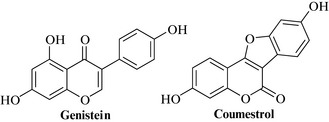Chapter 19 The endocrine system
Hypoglycaemic and antidiabetic herbs
Guar gum, Cyamopsis tetragonolobus (L.) Taubert (Cyamopsidis semen) 
Therapeutic uses and available evidence
The flour reduces pre- and postprandial glucose levels and is usually given with meals, and may also be of use in lowering blood lipid levels (Butt et al 2007). Like other bulk fibre preparations, it has other clinical effects such as the alleviation of diarrhoea, and it has been advocated as a slimming aid, and this does seem to be justified. It is also used as a thickening and suspending agent in foods, and as a tablet binder. The usual dose of the powdered gum is 5 g given with each meal. Few side effects have been noted, but patients treated with guar sometimes consider it to be rather unpalatable when made into foods.
Gymnema, Gymnema sylvestre R.Br.
Therapeutic uses and available evidence
The herb is a traditional treatment for diabetes in India but, although widely used, there is insufficient clinical evidence available to recommend this herb as yet. The antihyperglycaemic properties are due to the gymnemic acids and other saponins. Oral administration of a specific standardized extract OSA(R) (1 g/day, 60 days) induced significant increases in circulating insulin and C-peptide, which were associated with a reduction in fasting and post-prandial blood glucose. In vitro measurements using isolated human islets of Langerhans demonstrated direct stimulatory effects of OSA(R) on insulin secretion from human β-cells, consistent with an in vivo mode of action through enhancing insulin secretion (Al-Romaiyan et al 2010). The leaf extract also has hypolipidaemic activity in human patients and animals fed a high-fat diet (Kanetka et al 2007). The usual dose is up to 4 g of leaf daily. Gymnemic acids are well tolerated, but care should be taken when used in conjunction with other antidiabetic agents.
Karela, Momordica charantia L.
Therapeutic uses and available evidence
Both the fruit and the leaf have hypoglycaemic effects. The extract causes hypoglycaemia in animals and human diabetic patients, and several clinical studies have confirmed benefits (see review by Grover and Yadav 2004), but a recent Cochrane review (Ooi et al 2010) states that there is insufficient evidence to recommend it for type 2 diabetes mellitus, and that further studies are required to address issues of standardization and the quality control of preparations. It has also been used to treat asthma, skin infections and hypertension (Grover and Yadav 2004). Contraceptive and teratogenic effects have been described in animals, so care should be taken in pregnant women, although cooking the vegetable may well destroy many of the toxins.
Phytoestrogens
There are many plants that contain oestrogenic substances (phytoestrogens), and pharmacological and epidemiological evidence suggests that they act as mild oestrogens or, in certain circumstances, as anti-oestrogens (by binding to oestrogen receptors and preventing occupation by natural oestrogens). They generally have beneficial effects, including chemopreventive activity. As well as the herbs mentioned below, many pulses (which are legumes) contain phytoestrogens, as do linseed and hops. The main chemical types of phytoestrogen are the isoflavones, coumestans and lignans, and some species of palm even contain similar hormones (e.g. estriol) to those found in the human body. The common occurrence of these substances has implications for men as well as for women, in that the incidence of benign prostatic hyperplasia is lower in men, and menopausal symptoms in women, in societies consuming significant amounts of foods containing these substances in their normal diet. However, a recent case-control study in the UK found no significant associations between phytoestrogen intake and breast cancer risk, although colorectal cancer risk was inversely associated with enterolignan intake in women but not in men (Ward and Kuhnle 2010). Soya phytoestrogen intake may even have a beneficial effect on tumour recurrence (Roberts 2010). As the majority of studies have not involved women with breast cancer and are of short duration, it would be wise for patients with hormone-dependent cancers to avoid taking phytomedicines known to affect hormone levels.
Red clover, Trifolium pratense L.
Constituents
The major actives are phytoestrogens of two types: the isoflavones genistein (Fig. 19.1), afrormosin, biochanin A, daidzein, formononetin, pratensein, calyconin, pseudobaptigenin, orobol, irilone and trifoside, and their glycoside conjugates; and the coumestans coumestrol (Fig. 19.1) and medicagol.
Therapeutic uses and available evidence
Red clover was traditionally used for skin complaints such as psoriasis and eczema, and as an expectorant in coughs and bronchial conditions. However, it has recently been used more as a source of the isoflavones, for a natural method of hormone replacement therapy (for review, see Sabudak and Guler 2009). The isoflavones are oestrogenic in animals but the clinical use for menopausal women has not yet been well supported by clinical studies, except for a marginally significant effect for treating hot flushes in menopausal women (Coon et al 2007). Biochanin A inhibits metabolic activation of the carcinogen benzo(a)pyrene in a mammalian cell culture, suggesting chemopreventive properties. Red clover extracts also inhibit cytochrome P450 3A4 in vitro, which supports such a use. Red clover is considered safe.






